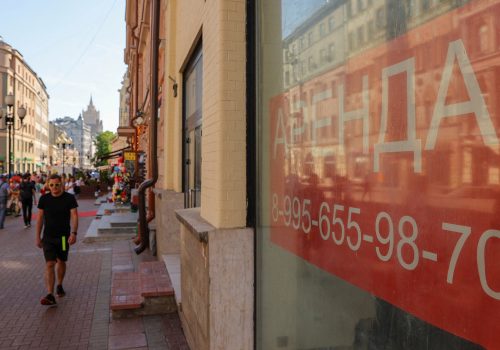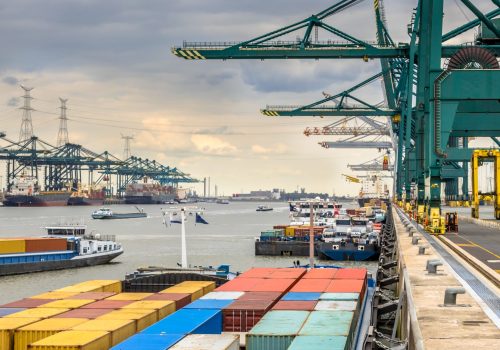May 24, 2023
Russia’s ‘data glasnost’ didn’t last long. Here’s how to tell whether sanctions are working.
Observers of the Russian economy have not been starved of data since the beginning of the war. It has been possible, for example, to obtain data on the balance of payments and on government revenue and spending, although the share of spending that is classified has grown to one third of total government spending this year.
Nevertheless, Russian Central Bank Governor Elvira Nabiullina and other financial elites have been pushing for making even more data available. Specifically, they are asking for data classified shortly after Russia’s full-scale invasion of Ukraine to be released again. This includes data on firms’ financial health and international trade. In part, the financial elites are defending their own technocratic power against backroom deals. More transparency may reassure investors and financial counterparties, be they financial institutions or governments that are not wielding sanctions against Russia.
There was some evidence that Nabiullina and her allies were beginning to win this battle in early March, with the release of very partial customs data and an up-to-date time series on the central bank’s foreign currency reserves—in addition to total reserves including gold, which had remained available and up to date.
By late March, the European Union had also contributed to this spirit of glasnost. Its self-reporting deadline forced member states to finalize their search for immobilized Russian assets, with the bulk of the much-publicized $300 billion thought to be found in the Belgium-based financial company Euroclear. The Russian central bank had been using safe government bonds as a store of value. As maturities were paid, up to 191 billion euros ($205 billion) accumulated there. There is no suggestion of any wrongdoing by Euroclear.
After these very small steps toward transparency—chosen by or imposed on Russia—it is now clear that the Kremlin is stopping this short-lived data glasnost experiment.
Brought in after the invasion, the “period of non-disclosure of corporate reporting” is meant to lapse on July 1. The usual suspects have been pushing for a return to transparency, arguing that—in addition to the positive signal it would send to investors—it would prevent healthy firms from securing tax breaks and subsidies. But Russian Finance Minister Anton Siluanov ruled out a return to pre-invasion practices on May 11, arguing specifically that this would put firms at risk of falling under Western sanctions merely for fulfilling government contracts.
Siluanov’s argument is somewhat puzzling. Most of the thirty-seven firms listed on the Moscow Exchange (including most metals producers) have published at least some of their 2022 accounts precisely to show that they are not supplying the Russian army—and thus to protect themselves from sanctions. In any case, it is a good reason for Western authorities to pay special attention to the thirteen listed firms that have taken full advantage of the non-disclosure period so far. As seen in data obtained from the Atlantic Council’s Russia Sanctions Database, most of the listed firms are sanctioned by only one or two sanctioning authorities, and some are not at all.
The Kremlin and the technocrats are perhaps readier to agree that Russia is not yet ready for capital controls to be lifted. This year’s much smaller trade surplus means a larger deficit in net investment and transfers would pull the current account into a deficit too. And there are already signs that Russia is worried about its access to currencies it can use to trade. In India this month, Foreign Minister Sergey Lavrov complained that rupees were accumulating in the Indian accounts of Russian exporters and that Moscow was struggling to put them to good use. In March, Nabiullina announced that all restrictions on withdrawing cash currency from bank accounts, money transfers abroad, and restrictions on withdrawals by non-residents from “unfriendly” countries would be extended.
Available data show sanctions are having an impact
Russia’s deficit is already well above the trajectory assumed in the 2023 budget. Figures released on May 10 by the Ministry of Finance show that the deficit from early January to early May has been over 3.4 trillion rubles ($42 billion)—already 17 percent above the deficit planned for the whole year. Lower oil and gas income over the first four months of the year (down 50 percent year-on-year) is partly to blame, but bloated spending and a sluggish 5 percent recovery of income from sources other than oil and gas are also factors.
The two most obvious resources to tap into—national welfare fund holdings and domestic borrowing—have been used sparingly so far.
The chart below shows that the ruble value of the fund—which is made up almost exclusively of yuan and gold for its liquid part—has in fact increased since the beginning of the year. The yuan withdrawals from the fund have been more than offset by the appreciation of the yuan and gold prices against the ruble. What has been withdrawn has been added to the central bank’s reserves in exchange for just 450 billion rubles ($5.6 billion), plugging only 13 percent of this year’s deficit so far.
Meanwhile, the finance ministry has issued just under one trillion rubles ($12.5 billion) in new OFZ bonds to the domestic market. Auctions for these remain popular as sanctions prevent Russian banks from investing in reliable assets abroad. On the other hand, this year’s auctions have not been as oversubscribed as the first large auctions late last year. Moreover, creditors are demanding a very high yield—more than 10 percent in annualized rates compared to a key interest rate at 7.5 percent—suggesting that they perceive significant risks ahead.
The remaining two trillion rubles ($25 billion) in the deficit so far have been covered out of the Russian treasury’s current account, which was claimed to be at 4.5 trillion rubles ($56 billion) in late February. The likely reason the government is running the risk of spending this down rather than borrowing or using the national welfare fund more is that it expects its fiscal returns to improve throughout the year. If this is indeed the case, it will have avoided causing an even faster expansion of money balances and sending another signal that inflation will pick up again.
The above chart shows that the shock to prices brought on by the invasion is now out of year-on-year inflation data. But the government and the central bank remain concerned that the weaker ruble and a loose fiscal stance could quickly bring inflation back above the 4 percent target. Also on May 11, Nabiullina commented that rates may have to be hiked again from their current 7.5 percent. Further cuts are now off the table.
Why might revenue improve? The quarterly tax on “extra oil income” introduced in 2019 is a crucial factor. This allows the government to track how exporters are selling into new markets and adjusting to the oil price cap rolled out by the Group of Seven (G7) nations in December and claim its share of the profit with a lag. This already helped recover some of the January and February losses in March. As for April, the government is also using a new formula for oil taxation. Based on the Brent crude index with a discount (which will shrink every month), the new formula shows that the government believes the index for Russian-made Urals crude is underestimating how much exporters are making, either by convincing buyers to disregard the price cap or by using a “shadow fleet” of shipping and insurance providers that are not affected.
It is now clear that this year’s budget deficit will be well above the planned 2 percent. The Russian government has several levers at its disposal to keep it from going out of control. It should be a key goal for Western policy to make sure these levers fail. In short, this means enforcing the oil price cap to exacerbate the deficit and allowing net transfers to keep leaving Russia in order to erode the current account surplus, keep the ruble weak, and exacerbate inflation.
Alongside capital controls, the end of the technocrats’ short-lived attempt at data glasnost is a clear sign that Russia will continue to run a wartime economy. Attractiveness to investors and the commitment to balanced budgets are no longer a priority. This means we could still see the Russian government breaking further economic taboos to keep financing its war. Pensions and other social payments were increased by 10 percent in June 2022 to account for high inflation but, with a growing deficit, even this key plank of Putinism appears to be at risk this year. Economists certainly expect the inflation-adjusted increase to be much more modest. Once the liquid part of the national welfare fund is depleted, the government might also start raiding the central bank’s accessible reserves, removing what remains of that institution’s ability to control inflation at all. At that point, the Russian economy could be in for much worse than a down year or two.
Charles Lichfield is the deputy director and C. Boyden Gray senior fellow of the Atlantic Council’s GeoEconomics Center.
Further reading
Thu, Feb 23, 2023
Sanctions alone won’t defeat Russia in Ukraine. But they’re having a bigger impact than it might seem.
New Atlanticist By Brian O’Toole, Daniel Fried
The Russian economy has begun to look like a leaky ship. All hands are on deck bailing it out, but at some point, they won’t be able to keep up.
Fri, Mar 24, 2023
Global Sanctions Dashboard: What to do with sanctioned Russian assets
Econographics By Kimberly Donovan, Maia Nikoladze
Immediate steps for seizing the sanctioned Russian oligarch assets; concerns with the confiscation of Russian sovereign assets; Georgia's proposed foreign agent law.
Wed, May 10, 2023
What is the G7 still exporting to Russia?
Econographics By Niels Graham
One year into the Russia's invasion G7 nations continue to export nearly $5B a month to Moscow. A new proposal by the US at the G7 could greatly reduce this.
Image: Russian President Vladimir Putin chairs a meeting on economic issues via video link at the Novo-Ogaryovo state residence outside Moscow, Russia, on April 11, 2023.


